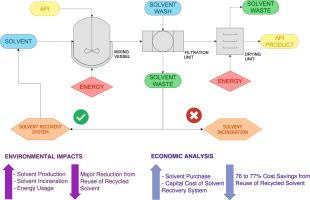迈向药物研究和开发的可持续实践:生命周期方法
IF 10.9
1区 环境科学与生态学
Q1 ENGINEERING, ENVIRONMENTAL
引用次数: 0
摘要
编制了原料药(API)纯化过程中冷却、抗溶剂、蒸发、反应结晶等工序的完整生命周期清单(LCI),涵盖了从原料提取到废弃物处理的各个环节,对溶剂进行了从摇篮到坟墓的评价。考虑了相关的环境影响类别,如全球变暖潜力、化石燃料潜力和人类毒性潜力,以量化整个生命周期阶段的环境负担。对溶剂回收和焚烧方案进行了比较,以评价环境影响。本文章由计算机程序翻译,如有差异,请以英文原文为准。

Towards sustainable practices in pharmaceutical research and development: A life cycle approach
A comprehensive Life Cycle Inventory (LCI) has been compiled for cooling, antisolvent, evaporative, and reactive crystallization processes during the active pharmaceutical ingredients (API) purification, covering aspects from raw material extraction to waste disposal, providing a cradle-to-grave evaluation for the solvents. Relevant environmental impact categories such as global warming potential, fossil fuel potential, and human toxicity potential were considered to quantify environmental burdens across the life cycle stages. A comparison between solvent recycling and incineration scenarios has been made to evaluate environmental impacts.
Environmental impact assessment indicated that solvent production was the primary contributor in the incineration option. However, implementing solvent recovery systems reduced these impacts, making the recovery option more environmentally favorable compared with incineraion. Economic analysis showed that operating costs are predominantly associated with solvent procurement. Further, solvent recovery systems showed high returns on investment at larger production scales, suggesting their viability for cost savings and profitability.
求助全文
通过发布文献求助,成功后即可免费获取论文全文。
去求助
来源期刊

Resources Conservation and Recycling
环境科学-工程:环境
CiteScore
22.90
自引率
6.10%
发文量
625
审稿时长
23 days
期刊介绍:
The journal Resources, Conservation & Recycling welcomes contributions from research, which consider sustainable management and conservation of resources. The journal prioritizes understanding the transformation processes crucial for transitioning toward more sustainable production and consumption systems. It highlights technological, economic, institutional, and policy aspects related to specific resource management practices such as conservation, recycling, and resource substitution, as well as broader strategies like improving resource productivity and restructuring production and consumption patterns.
Contributions may address regional, national, or international scales and can range from individual resources or technologies to entire sectors or systems. Authors are encouraged to explore scientific and methodological issues alongside practical, environmental, and economic implications. However, manuscripts focusing solely on laboratory experiments without discussing their broader implications will not be considered for publication in the journal.
 求助内容:
求助内容: 应助结果提醒方式:
应助结果提醒方式:


